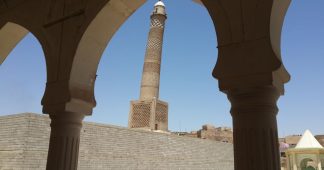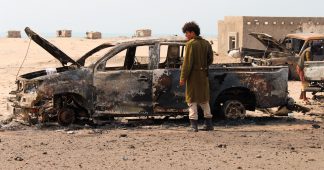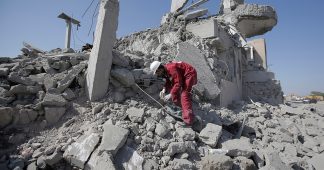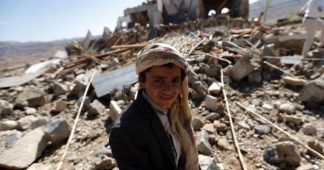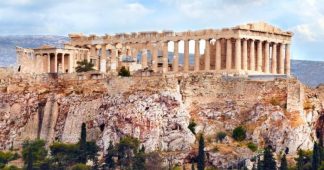Saada’s old city, which is among the world’s oldest human-carved landscapes, once consisted entirely of historic, centuries-old multi-story homes. Now, it has been wiped out, after Saudi Arabia declared it a military zone — even the city’s hand-carved wooden doors have been reduced to ashes
by Ahmed Abdulkareem
August 26th, 2019
SANA’A, YEMEN — Yemen was once described as a living museum, but U.S. made bombs dropped by the Saudi-led Coalition’s jets have not only killed thousands of civilians and led to famine and the spread of disease but also pulverized the country’s rich architectural history and left its inimitable heritage at the mercy of the highest bidder.
“I remember how light filtered through the stained glass of the patterned crescent window (qamarias) onto the white gypsum plaster in the resting room (Deirmanah) on the top floor. At night, lights tossed dapples of color into the sky,” Saleh Ali al-Aeini recounted to MintPress from his partially destroyed high-rise apartment, continuing, “Now, only scattered glass remains amid a mound of dust and mud, thanks to American bombs.”
Saleh’s ancient tower-house was one of four historic buildings in the old quarter of Sana’a that were destroyed by U.S. bombs dropped from Saudi warplanes in June, 2015. The buildings’ many-storied tower-houses, three of them rising to 110 feet, were more than 2,500 years old. The newest of them was more than 1,000 years old, built long before the United States even existed as a nation.
The effects of airstrikes on the UNESCO-listed Old City, perched on a highland plateau more than 7,200 feet above sea level, can be noticed at a glance. Cracks show on the more than 1,975 densely-packed homes, threatening them with collapse. Labyrinths, hidden gardens, steam baths, busy markets and streets have all been affected by airstrikes on the city that was said to have been founded by Shem, the son of Noah. In fact, the ancient city has been targeted at least four times with over 30 airstrikes according to the General Authority for the Preservation of Historic Cities.
Yet Saudi airstrikes extend far beyond Sana’a’s historic sites — to Sadaa, Shibam Hadramout, Zabid in Hodeida, Shibam Kuban, east of Sana’a, Shabwa, Aden, Amran, Taiz, and other areas of the country’s history that have also fallen victim to coalition bombing. Airstrikes and shelling have destroyed at least 66 historic sites according to Muhannad al-Sayani, chairman of the Yemeni General Authority for Antiquities
Coalition raids have targeted ancient castles and forts, museums, religious shrines housing cultural treasures; and ancient dams, including the world-famous Great Marib Dam.
Al-Sayani told MintPress that targeting of the country’s historic sites by the Saudi-led Coalition is deliberate: “These are open sites, mostly in desert areas where weapons cannot be stored.” Following many of the attacks, the Coalition often accuses the Houthis of using archaeological sites as weapons depots; however, no evidence has been provided to substantiate these allegations.
The undersecretary of the General Authority for the Preservation of Historic Cities, Amat al-Razzaq Jahaf, told MintPress that most of the monuments or sites have been damaged or destroyed by Saudi airstrikes since the Saudi-led campaign began without any justification.
The United States says it does not make targeting decisions for the Coalition. But it does support Coalition operations through arms sales, the refueling of Saudi combat aircraft, and the sharing of intelligence. Just last Thursday, a U.S. MQ-9 Reaper drone was downed in the city of Dhamar near the historic Dhamar Museum, which was leveled by a direct Saudi airstrike in June 2015.
Nothing can bring these back
Al-Aeini’s wife, who told MintPress than an American-made bomb had destroyed her home and killed her sons, accused international aid organizations of neglecting their suffering. “Lots of organizations visited us and provided only [promises] without doing anything,” she went on, “We rebuilt a part of the house by ourselves, just to have shelter for me and my husband, without any help.” Yemen’s General Authority of Antiquities complained to MintPress that the country’s heritage has been neglected by international organizations and communities.
Now, the buildings — which have stood tall for thousands of years in the historic city that surrounds the remnants of al-Aeini family home — are subject to eroding foundations and ominous cracks that line their ancient walls built of mud and stone, as a result of repeated Saudi attacks and the inability of Yemen’s government to address the deterioration amid four years of Saudi bombardment.
To make matters worse, Yemen is in the midst of its rainy season, adding to the challenges in rebuilding archaeological sites that have been targeted. “Of course, what has been destroyed is still devastating and every day the dangers [to those sites] is multiplied due to our inability to carry out operations to reduce the aggravation of damage because of the costs of rebuilding,” Jahaf told MintPress. Al-Qasimi’s house in Sultan’s orchard in ancient Sana’a, which was destroyed in another Saudi airstrike, is an example of this.
“If peace is brought to Yemen — and with it, compensation is provided — infrastructure, roads, schools, and hospitals could all be rebuilt; but nothing can bring back the historic architecture that has been destroyed,” Mohaned al-Sayani, chairman of the Yemeni General Authority for Antiquities, told MintPress.
Centuries in building, seconds in destroying
“Here, generations of my grandparents lived; why is it that the Coalition can so easily destroy it?” Hashem Ali, who fled to Sana’a after airstrikes leveled his family home in the historic Rahban area of Saada, asked MintPress. “This is the first time in nearly 600 years that my family is without a home.”
The attack on ancient Sana’a was the first of many violent assaults on Yemen’s architectural history, but the worst hit historic area has been Yemen’s northern province of Saada, the hub of the ancient Minaean Kingdom of Ma’in, founded before the fourth century B.C.
Saada’s old city, which is among the world’s oldest human-carved landscapes, once consisted entirely of historic, centuries-old multi-story homes. Now, it has been wiped out, after Saudi Arabia declared it a military zone — even the city’s hand-carved wooden doors have been reduced to ashes.
Just hours after the Coalition issued a warning on May 10, 2015, dozens of airstrikes rained down on the historic city, including on the ancient al-Hadi Mosque, which was founded nearly 1,200 years ago and is the final resting place of Imam al-Hadi ila’l-Haqq Yahya, the Zaydi imam of Yemen
To understand Saudi Arabia’s motivation to essentially exterminate Yemen’s heritage, one must understand Yemen’s history as well as that of Saudi Arabia and the United Arab Emirates and the Saudi-based Wahhabi faith, which provides religious justification for targeting heritage sites under the guise of eradicating polytheism.
In ancient times, Yemen was home to several flourishing civilizations — including Ma’in, Qataban, Hadramaut, Ausan, Himyar and Saba (Sheba), which lasted for 11 centuries and was mentioned in the Quran and other ancient holy books. The Saban civilization was marked by its distinctive architecture, based almost entirely on local building materials, a style unique in the Middle East.
In contrast to Yemen’s rich and ancient history, civilization did not make its way to the Arabian Gulf until the 1930s. The United Arab Emirates, Saudi Arabia’s fellow coalition war partner, didn’t take root until 1971.
Many Yemenis, including Saleh Ali al-Aeini, believe that Saudi Arabia harbors severe jealousy over Yemen’s history and heritage and the unique role that it has played in human history. According to some historians, that history spans 60,000-70,000 years, when the country received its first Homo sapiens who migrated across the Red Sea from Africa to the Middle East before traveling west to Europe and east to Asia and Australia.
Moreover, Wahhabism — the official state religion of Saudi Arabia, based on a puritanical and widely rejected interpretation of Islam — sees the preservation of historic and religious sites as tantamount to idolatry. The Wahhabi establishment in Saudi Arabia has not even spared the Kingdom’s own tombs and monuments in Mecca and Medina and shows special disdain for Yemen’s historic sites, especially those located in northern Yemen, the seat of the Shia Zaydis for over a thousand years.
Looting what was not destroyed
Yemenis see their historic sites as a social-cultural fabric linking generations to their early ancestors. “I’ve lived here for dozens of years but now I have no house; there are no more gatherings of my ones-loved on the weekend,” al-Aeini said. He continued: “Another thing to worry about is our remaining legacy being looted.”
Destruction from the air is not the only threat to Yemen’s ancient legacy. During their war in Yemen, Saudi Arabia and the UAE have established smuggling networks in the country to loot historic sites.
A.M.M., who asked to be identified only by his initials, worked as an antiquities smuggler for a security outfit based in the UAE. A.M.M. told MintPress that his team sold four 2,500-year-old mummies, a gilded Torah scroll, and dozens of bejeweled daggers from the early Islamic era. “They always stressed the importance of keeping [the items] from being damaged so that they will be accepted by their American friends,” he said.
The smuggling of Yemeni antiquities is often carried out by diplomats operating out of Yemeni embassies from Saudi Arabia, the UAE, Bahrain and Egypt in return for lucrative sums of money allegedly provided by patrons from the United States and Israel. Yemen is the cradle to many civilizations and home to multiple faiths — particularly Judaism, Christianity and Islam, which all thrived in Yemen for millennia. For the Israelis, many of Yemen’s antiquities are seen as the rightful property of the Jewish people and there is reason to believe that Israel is also involved in the looting of Yemen’s heritage.
Officials in Sana’a say they have strong evidence that Yemeni artifacts are being sold off to American and Isreali buyers. “Artifacts featuring the Star of David or Jewish names are our priority; they often fetch a higher price than the other artifacts,” A.M.M told MintPress. “I sold one Hebrew manuscript to a UAE officer for $20,000,” he added.
Aden, in the eastern province of Marib, is favored by smugglers for shuttling stolen artifacts abroad. Here — according to the testimonies of a number of smugglers arrested by Houthi forces and now serving their sentences Sana’a’s Central Prison — smugglers are able to work in broad daylight in facilities provided to them by high-ranking officials in the ousted government of President Abdrabbuh Mansur Hadi, with direct coordination of both Emirati and Saudi officials.
More weapons to destroy what remains?
“We want compensation to rebuild our house again,” al-Aeini said, perched atop the stone rubble of his destroyed ancient home. “We should get compensation from the Americans. American bombs have killed more of us than were killed in the September 11 attacks.”
Al-Aeini was sardonically referring to the duality of moral attitudes in the United States, where on one hand Saudi Arabia is asked to pay compensation to the families of victims of the September 11 attacks, yet do nothing for victims of the war in Yemen, who are often killed with U.S. weapons sold to Saudi Arabia. “If there hadn’t been an American bomb, I would be at home now with my children and grandchildren, but they took everything,” al-Aeini said.
Many Yemenis are pessimistic about the future of their heritage. They say President Donald Trump’s recently-announced sales of U.S. weapons to Saudi Arabia and the United Arab Emirates will destroy what remains of their country’s legacy. The sale includes precision-guided missiles manufactured by Raytheon as well as precision guidance parts for Paveway IV bombs used on Eurofighter and Tornado warplanes — the same type that have been blamed for much of the destruction of Yemen’s historic sites and civilian casualties alike in the Saudi-UAE air campaign in Yemen.
An old Yemeni proverb used for generations to encourage the preservation of the country’s rich heritage reads Eli maluh awal maluh taley (Whoever has no first, has no second). Many Yemenis, al-Aeini among them, fear that Yemen is already losing its heritage, much like al-Aeini lost his home, to American weapons.
Feature photo | People stand amid the rubble of the site of a Saudi-led airstrike in the old city of Sana’a, Yemen, Sept. 19, 2015. The airstrikes hit an apartment building in the center of the capital, a UNESCO world heritage site, killing a family of nine. Hani Mohammed | AP
* Ahmed AbdulKareem is a Yemeni journalist. He covers the war in Yemen for MintPress News as well as local Yemeni media.
Published at https://www.mintpressnews.com/us-israel-collectors-buy-yemen-ancient-historic-sites/261519/
